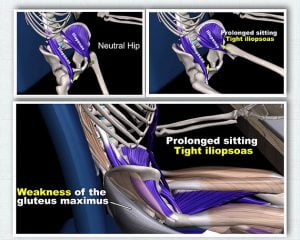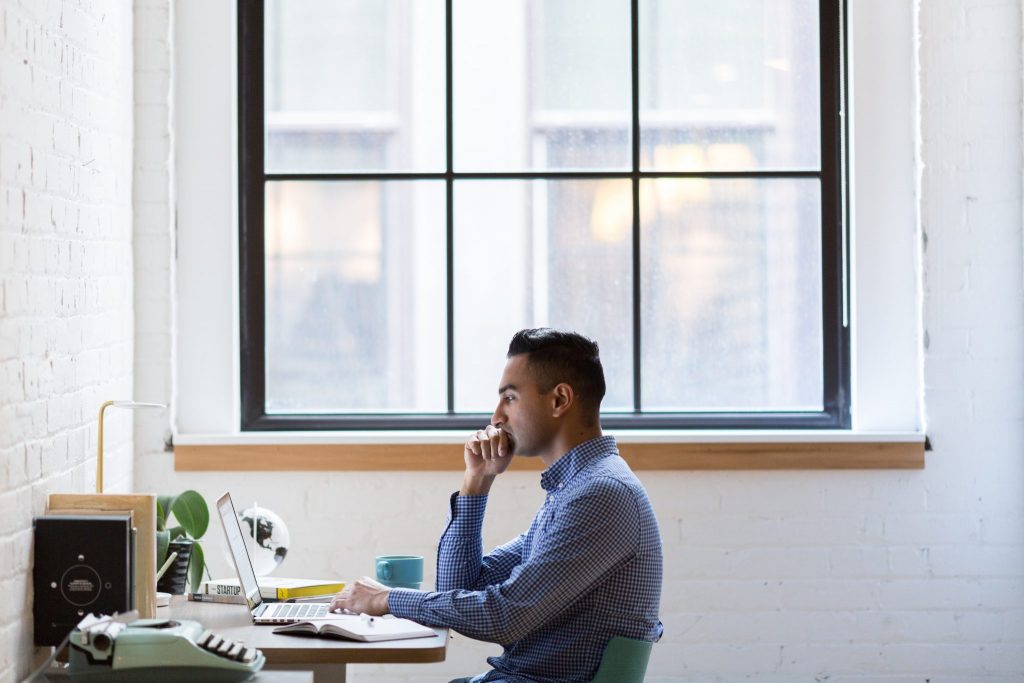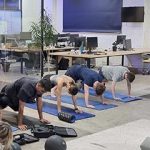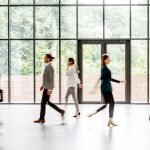Hi Readers,
Today at Functional For Life we have decided to highlight an issue that is going to be highly relevant to people in many workplaces. Sitting down and it’s impact on the body. As usual this is a complexed topic so today we are going to focus on just one area of the body, the muscles around the hips.
There are a number of large and powerful muscles around the hip complex. When it comes to sitting there are two muscles in particular that need to be understood:
-
The iliopsoas
-
The gluteus Maximus

photo credit: www.muscleandmotion.com
Both of these muscles can be seen on the images above. As you will see in these pictures, when we are sitting down the iliopsoas (also known as the hip flexors) muscle is in a shortened position in comparison to if we were standing up. On the contrary the gluteus maximus (the most powerful muscle in the body) is in a stretched/lengthened position.
You may be wondering what the relevance of this is and why this is the case? To put it simply almost all muscles in the body work in pairs. That is when one is contracting the muscle that opposes it will relax. The easiest way to understand this is the bicep and tricep. When we bring our hand up towards our shoulder, our bicep shortens (contracts) in order for this to happen the tricep (muscle in the back of the upper arm) must relax and lengthen.
This is the same idea for the gluteus maximus and the hip flexors (iliopsas) for the hip flexors to shorten (contract) as they do when we are sitting, the gluteus maximus must lengthen and relax to some degree.
Why does this cause issues?
In short it causes a muscle imbalance in the body where one muscle (hip flexor) is working harder for an extended period of time than its partner muscle (gluteus maximus). Below we will highlight a few of the problems with this and how it can impact us:
-
Glute Amnesia. This is where our glutes have issues activating/firing as over time the path ways from the brain to the glutes that tells them to fire becomes less efficient. This means when you are doing day to day activities that involve hip extension i.e. any walking, running the gluteus maximus is not working as efficiently as it could be. It would be like a 6 cylinder car running on 3 cylinders. It will still work but not to it’s full potential. Without going into detail this can also cause issues with the hamstrings as they need to work harder than they should to compensate for the glutes ‘slacking off’. To counter this we recommend glute activation exercises.
-
Position of the Pelvis: Sitting for extended periods of time can mean your hip flexors along with one of the quadricep muscles (rectus femoris) can become chronically short. This can lead to a forward tilt of the pelvis. In an ideal world and for the best movement efficiency we want our pelvis to be neutral, so an anterior tilt is not ideal. To counter this we recommend release (through massage or self massage) and stretching.
Whilst it can lead to other issues as well, these are two major issues worth focusing on. Muscle imbalances are one of the most common causes of musculoskeletal pain. Not only can the hip flexor, glute relationship lead to pain the imbalances can also lead to greater risk of acute injury in day to day movements.
Ideas for dealing with this?
From a day to day perspective, try to avoid sitting down for extended periods of time at work. Aim to get up and move around every 20 minutes or so. Standing desks are becoming more prominent in the work place due to some of the reasons we have discussed in this blog. If you do have standing desks available at your work we suggest you aim to use them as often as possible. Furthermore, sitting in positions where you are not resting your back on a back rest i.e. a stool, swiss ball, the edge of your seat will force a lot of your postural muscles to engage and work which is much better than having them slacking off for most of the day.
From a training perspective aim to include glute activation exercises. There are plenty of ideas for this on Youtube, however one of the most common ones are glute bridges. Looking to include stretches and releases for your hip flexor muscle is also a good idea. A common hip flexor stretch is the kneeling hip flexor stretch and again there are plenty of great ideas for this on Youtube and Google. Finally if you do believe you have postural issues due to sitting down it is always recommended you see a physio or a GP to provide you with more specific advice on what to do.
Just remember sitting for long periods of time, generally leads to adverse affects on the body. We hope you can take some tips out of todays blog! For more tips and advice on functional movement check out www.functionalforlife.com.au
Warning: The training and instructional content contained on this website should be taken as information and not medical advice. Please consult your health professional before attempting these exercises.






